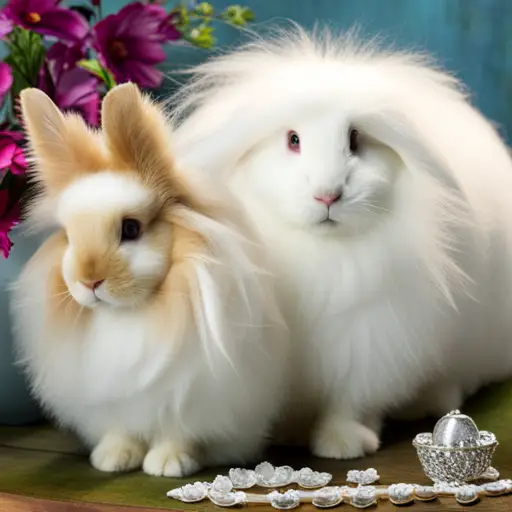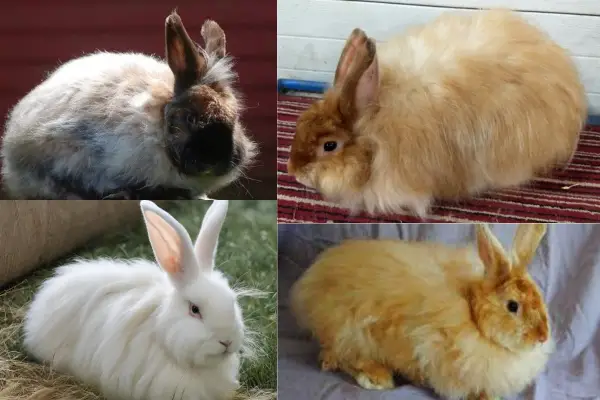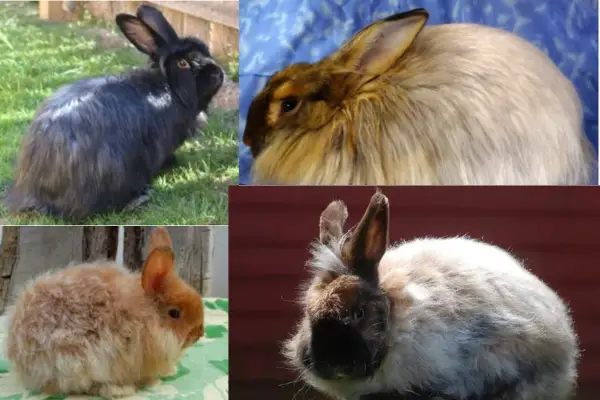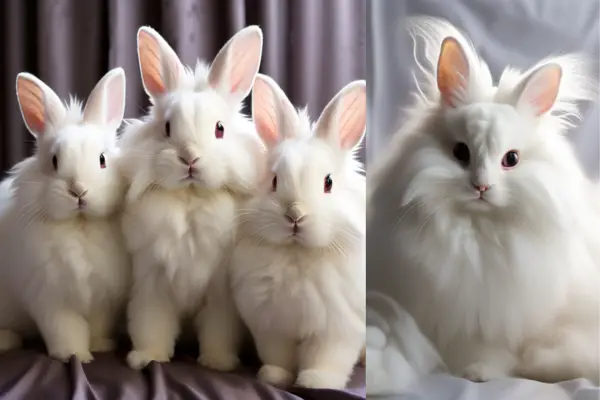The Satin Angora rabbit breed produces some of the finest, shiniest wool of any rabbit. With their soft, densely-packed fur, Satins make great pets, wool producers, and show bunnies. Read on to learn all about this unique breed.
Origin
The Satin Angora rabbit originates from breeds like the French Angora, English Angora, Satin, and Commercial White. By crossing these types, breeders aimed to develop a rabbit with superior wool qualities. The result is the lovely Satin Angora we know today.
This breed stands out for its unusually soft, shiny, smooth coat. The fur lacks the fluffy appearance seen in other Angoras. Instead, the hairs align tightly together to showcase the signature glossy sheen. This gives finished Satin Angora projects a richer, more luxurious look and feel.
Appearance and Size
Satin Angoras are medium-sized rabbits weighing 5 to 7.5 lbs. Their compact bodies feel surprisingly dense and muscular under all that fluff.
This breed sports a commercial body type. The ideal build has a rounded, evenly balanced shape with good depth and width. Hindquarters should appear rounded and well-fleshed.
The head is compact yet proportional to the body. It will be nicely rounded from the front and broad across the top behind the eyes. Medium-sized ears stand firmly erect. They are V-shaped with rounded tips tilted slightly forward.
Coat Quality Standards
A Satin Angora’s coat consists of two fiber types: soft underfur capped by smooth, glossy guard hairs. The ideal length ranges from 2 to 4 inches when stretched gently. Any shorter and the coat loses silkiness. Any longer and grooming becomes difficult.
Fur density should allow the skin to just barely show through when parted. The coat falls smoothly along the sides in a natural part revealing silky belly fur. Fur on the flanks appears especially abundant. The chest sports a profuse mane.
Only white Satin Angoras meetshow standards. However, breeders develop lovely pastel varieties like chinchilla, tortoiseshell, blue, and black.
Temperament
Despite their diva-like looks, Satin Angoras tend to act more mellow and friendly than some small breeds. They seem to enjoy human interaction. Most tolerate handling reasonably well if socialized young.
Satins still appreciate respect, though. Noisy environments, rough hands, or insensitive treatment tends to disturb these sensitive souls. With gentle care, confidence-building playtime, and positive reinforcement, however, they transform into delightful companions.
Their calm personalities also make Satin Angora bucks easier to work with than males of twitchier types. That said, experts don’t recommend them as first-time house rabbits. Their long fur demands more grooming commitment than beginners may handle.
Housing Satin Angoras
As an indoor breed, Satin Angoras thrive best living alongside their owners. Housing them in isolated hutches or outdoor cages invites stressful boredom. Lonely Satins may even overgroom themselves from the anxiety.
Owners ideally allow house access at least portions of the day. During free roam periods, bunny-proof any exposed electrical cords, toxic houseplants, and other hazards. Protect vulnerable furnishings as well since some enjoy nibbling carpet edges or woodwork.
Their living space should also include a roomy pen or cage, a snug retreat house, litterboxes, and toys. Ensure the enclosure allows enough hopping room for physical activity. Drafty areas must have wind blocks since Satins feel temperature extremes more keenly.
Lastly – and perhaps most critically – provide multiple brushing and grooming tools. Mats painfully tug at a Satin Angora’s skin if not gently worked out daily. We’ll cover proper grooming techniques shortly.
Feeding and Nutrition
Feeding Satins calls for balancing two key nutritional needs:
- High-quality protein for health, growth, and replacement of wool
- Adequate fiber to keep the digestive tract functioning smoothly
About 20% of their diet should consist of timothy hay or grass hay. This provides vital roughage. Too little fiber causes deadly gastrointestinal stasis. Mixing in a handful of fresh greens also adds fiber and micronutrients.
The rest of the diet covers protein needs. Top choices include:
- Pellets made specifically for Angora rabbits
- Oat groats and rolled oats
- Bermuda grass hay
- Alfalfa hay
Maintain a consistent feeding schedule while avoiding sudden diet changes. This helps keep sensitive digestive systems stable. Monitor your Satin Angora’s body condition as well. Under or overweight rabbits risk health complications.
Grooming Requirements
That glorious satin sheen doesn’t maintain itself! Satin Angoras need thorough grooming at least every other day to avoid disastrous matting. Ideally, they receive a 5-10 minute once-over daily.
Work bottom to top using these tools:
- Slicker Brush – lifts out loose undercoatFirst detangle the ends, then brush against fur growth to lift dirt while stimulating the skin. Move slowly to minimize pulling.
- Fine-Tooth Comb – smooths and parts the furAfter brushing, run the comb through sections of hair to check for sneaky tangles. Pay extra attention to problem spots: behind ears, flanks, hindquarters, genitals, paw tufts.
- Nail Trimmers – neatly trim sharp claws Don’t forget to snip those constantly growing nails! Take care not to cut the quick. Have styptic powder ready to stop bleeding if needed.
- Mist bottle – tames flyaway furLightly misting lets you slick down flyaway guard hairs. Alternatively, lightly dampen hands then stroke to neaten the coat after grooming. Air drying naturally restores full silkiness.
Shedding and Wool Harvesting
Satin Angoras blow their coats once or twice a year. During shedding periods, increase grooming to help free the old hairs. Collect everything you brush out! Harvested Satin Angora fur spins into heavenly light, warm yarn and commands premium pricing.
Between sheds, pluck very loosely-rooted fur rather than cutting hair to collect wool. Take only a little from a few spots per session to minimize irritation. Gather the pluckings into sorted bags: white usable fiber in one, waste in another. Sorting now saves effort later.
Health and Litter Habits
Reputably hardy, Satins tend to remain active and healthy into elder years with attentive care. They become sexually mature by approximately 4 months old. Does can deliver litters of 4-6 kits every 90 days once bred.
Maintain breeding does in top condition to support such frequent kindling. Separate kits from the mother around 8 weeks old to avoid accidental breedings back to her or littermates.
To track family lines for your Satin Angora breeding program, tattoo kit’s ears at weaning. Other key health practices include spaying/neutering non-breeding animals and keeping vaccinations current. Schedule annual checkups to monitor for dental issues, parasites, overgrown teeth, and feet problems.
The FORS System for Assessing Wool
When evaluating Satin Angora wool quality, exhibitors apply the “FORS” system:
1. Fineness – fiber diameter relative to breed Character – degree of crimp across locks Density – number of fibers per square inch Uniformity – consistency of other FORS traits
2. High-ranking wools feature thin, tightly crimped fibers densely packed in organized alignment. The more uniform the sample, the better. This produces flawless sheen and lightweight yarns.
Satin Angora Breed Conservation
Despite their specialty appeal among hand spinners, Satin Angoras remain a “Watch” breed on conservation lists. This means while not yet endangered, their limited gene pool and niche popularity put them at future risk.
Breeders must carefully select breeding stock for genetic diversity. Raising awareness of these charming rabbits also helps ensure future generations can enjoy their exceptional fleece. Support specialty breeders in your area or consider becoming one!
Where to Acquire Satin Angoras
New owners have a few options for adopting Satins:
- Local rabbit rescues – Many general rescues end up with abandoned lop-eared mixes. Check Petfinder for adoptable Angoras in your state.
- Private breeders – Contact area ARBA members via the club’s directory. Attend shows to network with local breeders as well.
- Online groups – Facebook groups like “Satin Angora Rabbits” connect distant buyers and sellers.
Purchase cost ranges widely from 25-150+ depending on bloodlines, age, quality, and other factors. Ask to see the parents when possible ensure healthy stock. Avoid sourcing from flea markets or retailers selling rabbits solely as livestock.
Final Words!
The Satin Angora rabbit breed stands in a league of its own with its lavishly silky fur. Breeders crossed multiple types with superior wool and sheen to develop this glamorous yet friendly rabbit.
From their exacting grooming needs to specialized diet and housing considerations, Satins prove more high-maintenance than typical pets. Their exceptional fiber makes the effort worthwhile for spinners and textile artists. Even as “just” beloved house rabbits, their affectionate personalities shine through.
Satin Angoras remain rare, but dedicated breeders work to conserve the gene pool. Educate yourself thoroughly before bringing one home. If properly understood and cared for, they transform into extraordinarily rewarding companions. Their silk-spun wool and polished presence bring exceptional joy into the lives of the lucky few able to share life with these special rabbits.




